- Why choose autumn for the Camino de Santiago?
- Which Camino routes are ideal in autumn?
- Essential preparation for the Camino in autumn
- Practical tips to enjoy the Camino in autumn
- Possible inconveniences of the Camino in autumn
- Testimonials from pilgrims who walked the Camino in autumn
- Is autumn the best time to walk the Camino de Santiago?
Autumn is the perfect season for those who seek to enjoy the Camino de Santiago in a calmer way, with fewer crowds and a spectacular landscape. During this time, the weather is still pleasant, though it may surprise you with some rain, and the colors of the landscapes, full of golden and red tones, create a unique atmosphere for the pilgrimage. In this guide, I will share why autumn is an excellent choice to walk a Jacobean route, which routes to choose, and how to prepare for an unforgettable experience.
Why choose autumn for the Camino de Santiago?
Autumn is undoubtedly one of the best times to walk the Camino de Santiago. I had the opportunity to walk it in this season, and it was a unique experience. There is something special about this time of year that cannot be compared to the summer crowds or the winter cold.
Fewer crowds and greater tranquility
One of the biggest advantages of walking the Camino in autumn is the fewer number of pilgrims. The routes are much less crowded, allowing you to enjoy the peace and tranquility this journey offers. During my walk, I felt how silence and calm enhanced the experience. You can take your time, reflect, and enjoy without rush.
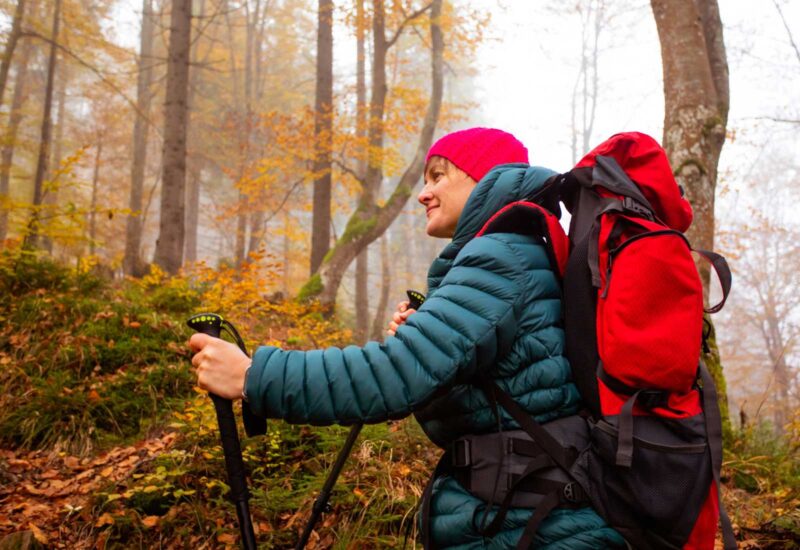
The Camino de Santiago in autumn is an experience you can’t imagine and will pleasantly surprise you
Milder weather and autumn landscapes
Although it may rain (and sometimes a lot), autumn weather is milder compared to the summer heat or winter cold. The fresh air and pleasant temperatures make walking much more enjoyable. Also, the landscapes transform with the golden, red, and orange colors of fallen leaves. For me, seeing how nature changes color was an impressive visual spectacle.
A more authentic and reflective experience
Autumn is a more introspective time to walk the Camino. With fewer pilgrims around, you can connect better with yourself and with the surroundings. This calm and serene atmosphere, surrounded by nature at its peak, makes the journey more authentic, reflective, and personal. It’s not just a physical journey, but also an emotional and spiritual one.
Which Camino routes are ideal in autumn?
Autumn is a fantastic time to walk various routes of the Camino de Santiago. Each one has its own charm and challenges, and all offer a unique experience during this season. From Viajes Camino de Santiago, we recommend the following.
French Way
The French Way remains one of the most popular routes, but in autumn, overcrowding decreases significantly. The views of the vineyards in La Rioja or the fields of Castilla with the golden autumn background are spectacular. If you’re looking for a complete experience, with many hostels and a lot of history, this is an excellent option. Also, you can consider the French Way from Sarria, one of the most popular sections for its accessibility and beauty. Another interesting option is the French Way from O Cebreiro, which offers breathtaking landscapes as you cross the Galician mountains.
Portuguese Way
The Portuguese Way is perfect for those who seek tranquility without straying too far from civilization. It is one of the least crowded routes compared to the Camino Francés, and in autumn, you can enjoy a mild climate without the summer crowds. The coastal and rural landscapes during this season are truly beautiful, making the walk even more enjoyable. You can also choose the Portuguese Way from Tui, one of the most traditional starting points for this route.
Portuguese Coastal Way
The Portuguese Coastal Way is a variant that runs along the Atlantic coast, from Porto to Santiago. It’s a great option for those looking to enjoy beautiful sea views. If you start this alternative from the Portuguese Coastal Way from Vigo, the route blends coastal landscapes with small fishing villages, offering a unique experience next to the ocean.
English Way
The English Way from Ferrol is an ideal route for those with less time but who still want to experience the Camino. With few kilometers to cover, it’s perfect for enjoying the tranquility of the Camino while passing through less-traveled Galician landscapes.
Way to Finisterre and Muxía
The Way to Finisterre and Muxía is one of the most symbolic and mysterious routes of the Camino de Santiago. After reaching Santiago, you can continue your pilgrimage to the End of the World, where the ocean and cliffs offer breathtaking beauty. It’s a spiritual and moving journey that many pilgrims choose to undertake to conclude their pilgrimage.
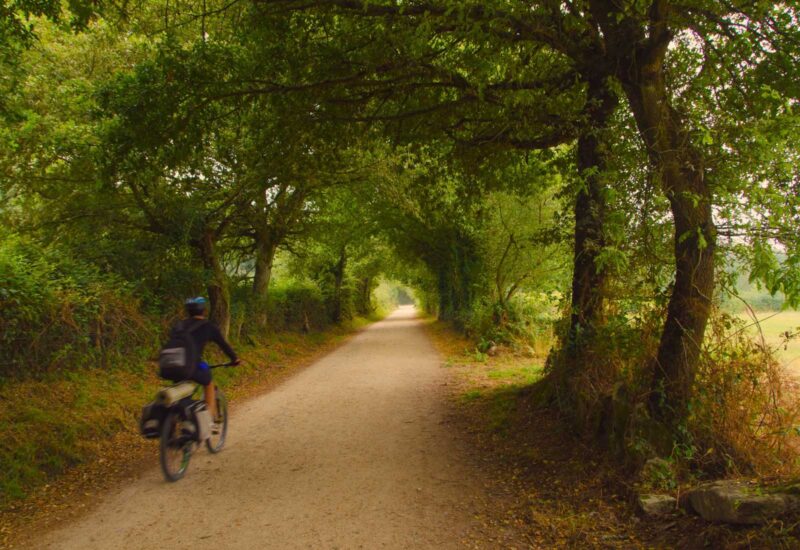
A pilgrim cycling on the French Way
Essential preparation for the Camino in autumn
If you decide to embark on the Camino de Santiago in autumn, it is crucial to be well prepared for the changing weather and route conditions. Take note:
- Appropriate equipment for autumn weather: One of the most important items is clothing. Make sure to bring breathable clothes that allow you to adapt to temperature changes. During the day it can be warm, but the nights and mornings are cool, so bring light clothing, but also coats and rain layers. A good raincoat is essential!
- How to organize your backpack for the season: My personal advice is to pack light but efficiently. Bring the essentials, but also extra clothing for rainy and cold days. A good pair of waterproof boots will make the mud and rain no problem.
- Backpack transport considerations: Along the Camino, you can take advantage of the backpack transport service to lighten your load. This will allow you to walk more freely and focus on enjoying the scenery and the experience without carrying extra weight.
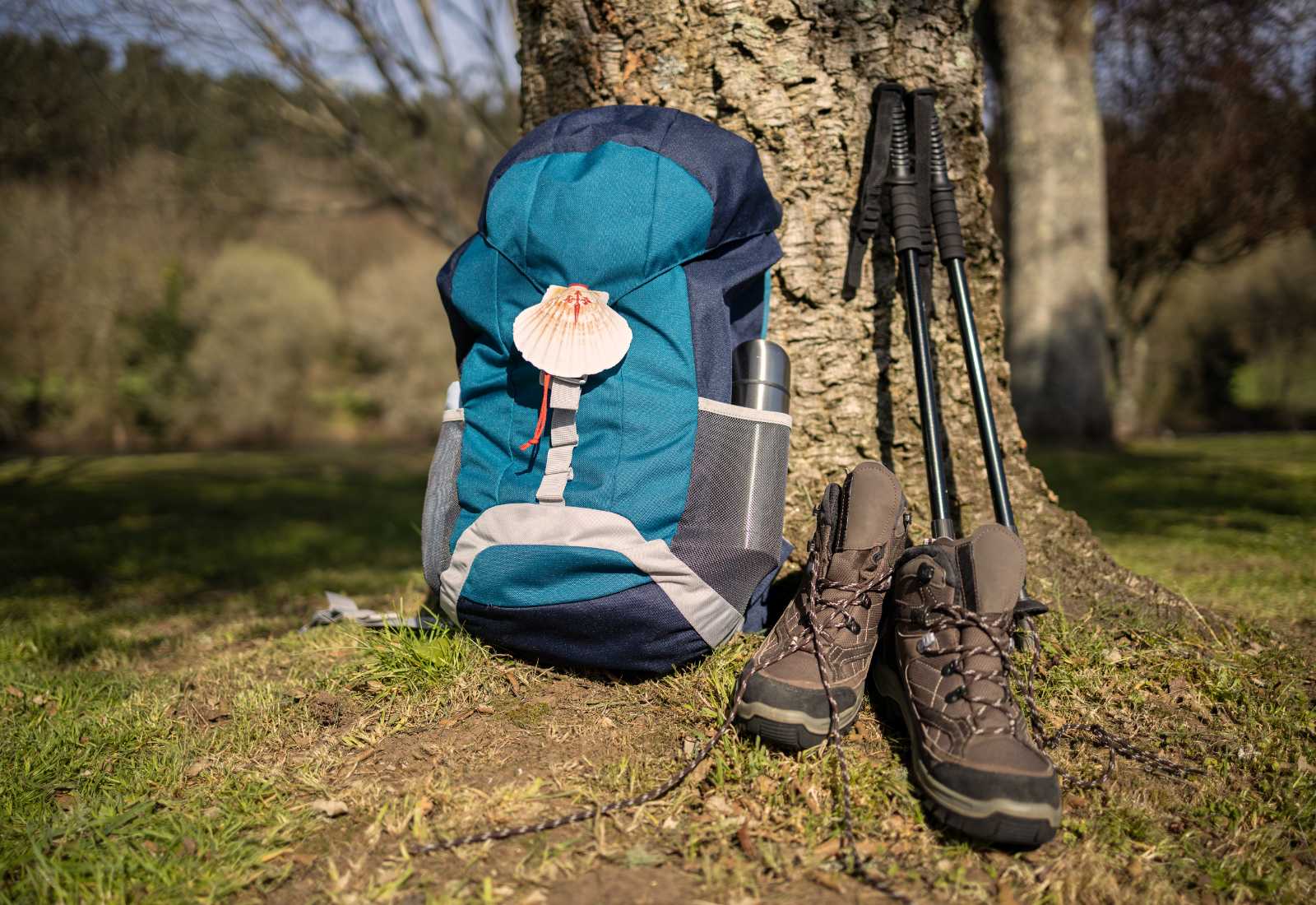
You know, less is more, and when doing the Camino de Santiago, you shouldn’t overload your backpack
Practical tips to enjoy the Camino in autumn
Walking the Camino in autumn has its peculiarities, but with these practical tips, you’ll be able to enjoy the experience to the fullest:
- Adapt to changing weather conditions: Autumn weather is unpredictable: you can have both sun and rain on the same day. The key is to be prepared for anything. My experience taught me not to let a bit of rain spoil the mood. Rain or shine, there is always beauty to discover on the Camino!
- Take advantage of the fewer pilgrims: With fewer people on the Camino, you can enjoy more conversations with other pilgrims and the feeling of being on a personal journey. The atmosphere is much more relaxed, allowing you to experience the Camino more deeply.
- Enjoy local food and culture: Autumn is the season for chestnuts, young wine, and cider in Galicia. Take the opportunity to enjoy the local flavors, which are an integral part of the Camino experience. Restaurants offer seasonal menus that will let you enjoy authentic and comforting cuisine.
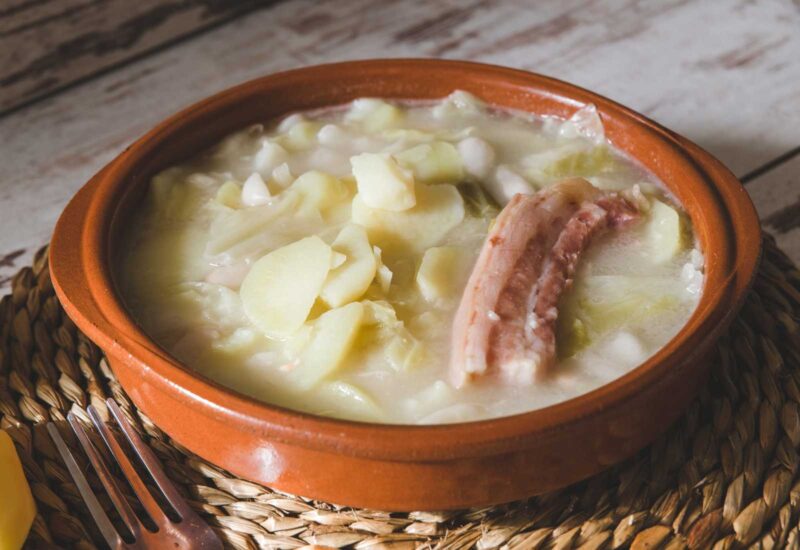
Galician cuisine has very autumnal dishes, like this Galician broth, a revitalizing meal for the pilgrim
Possible inconveniences of the Camino in autumn
Although autumn is a wonderful time to walk, it also presents the following challenges:
- Shorter days and less sunlight: One disadvantage is that the days are shorter. It’s advisable to start walking early to make the most of the daylight hours. Don’t forget your flashlight in case you arrive a bit late at the hostel!
- Risk of rain and humidity: Yes, rain is a real possibility, especially in the northwest of Spain, and it’s important to know what to do if it rains. Always bring waterproof clothing and cover your backpack to protect it from moisture. Despite the rain, I assure you that the atmosphere and the peaceful landscape make up for everything.
- Reduced services on some routes: Some routes, especially the more remote ones, may have fewer services available in autumn. It’s advisable to check in advance the availability of hostels and services on your route to avoid setbacks.
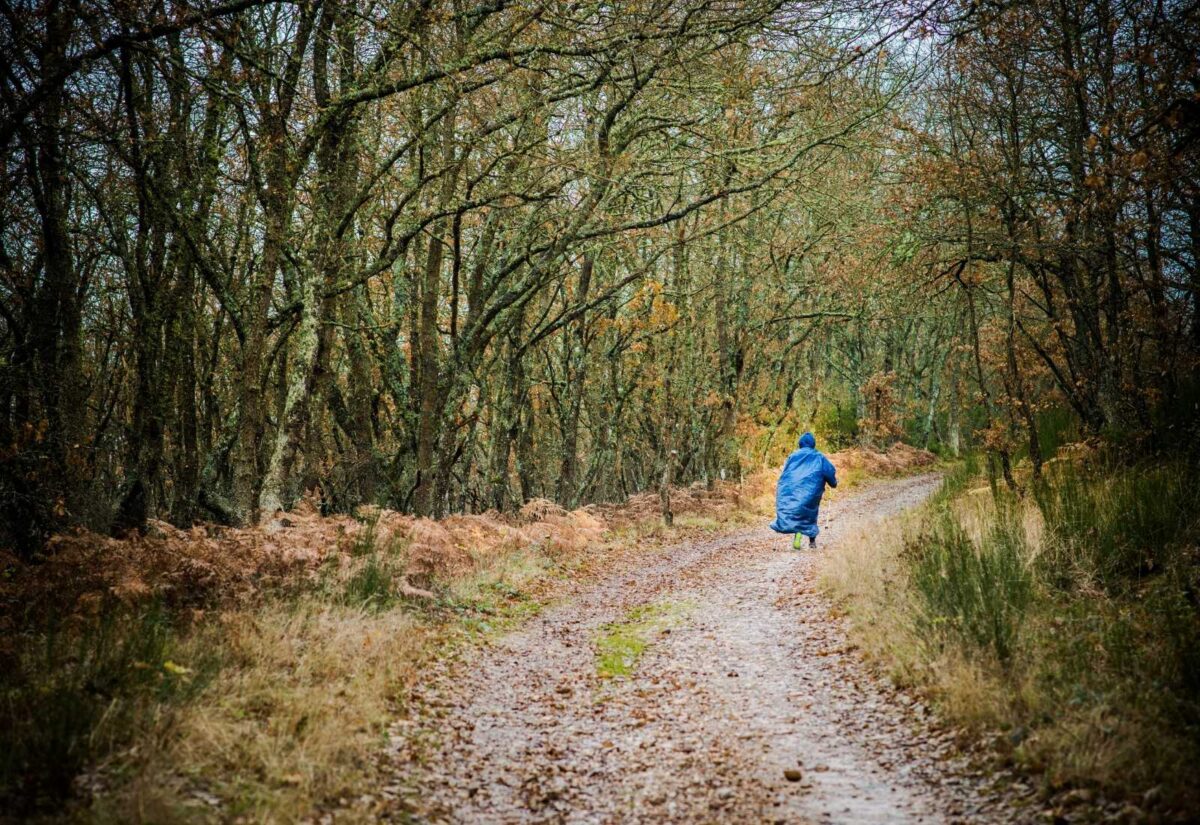
Pilgrim walking with raincoat in a very autumnal landscape
Testimonials from pilgrims who walked the Camino in autumn
Hearing from other pilgrims is always enriching. During my Camino in autumn, I had the pleasure of meeting many travelers who, like me, were looking for the serenity and beauty of this season. They all agreed that autumn brings a sense of closeness to nature and introspection that is not experienced at other times.
Personal experiences and recommendations
One of the pilgrims I spoke with mentioned that walking in autumn allowed him to enjoy the details of the Camino more calmly, without hurry, and without the hustle and bustle that usually exists in the summer months. Additionally, the serenity of nature during this season was a transformative experience for him. Autumn, with its fresh air and landscapes painted in golden and reddish tones, has a special power to connect the pilgrim with the environment and with themselves. For me, the impact was deep, and it allowed me to reflect on the journey while watching how nature prepares for winter.

Pilgrim crossing a forest in autumn
Is autumn the best time to walk the Camino de Santiago?
Without a doubt, autumn is one of the best times to walk the Camino de Santiago. Fewer crowds, milder weather, spectacular landscapes, and a more personal experience make this season the ideal option for those seeking a calmer and more authentic pilgrimage. If you have the opportunity, don’t hesitate to live this unique experience… and I hope you enjoy it as much as I did!

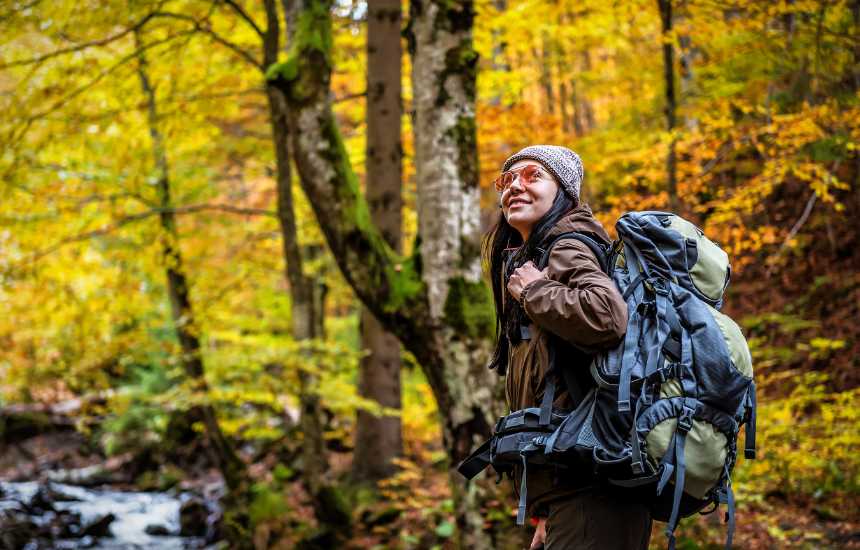










Leave A Comment